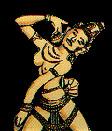Hoa này có ý nghĩa tượng trưng mạnh mẽ đối với người Hindu và Phật giáo, vì thế nó được gọi là hoa ở các đền thờ. Có lẽ đó là lý do tại sao người Chàm yêu mến loài hoa này và xem nó là biểu tượng của đất nước họ vào thời nước Chiêm Thành còn là một quốc gia chịu nhiều ảnh hưởng Ấn Độ độc lập ở miền trung Việt Nam ngày nay. Khi người dân Việt và vua Lê Thánh Tôn chiếm đất nước này, người Chàm buộc lòng phải phân tán ở Đông Dương, đặc biệt là ở Lào và Cao Mên, mang theo cây này. Hoa này được người Lào gọi là Dork Champa để tượng trưng cho hoa bị người Chàm bỏ rơi. Người Lào sau đó đã sử dụng nó cho quốc gia của họ khi họ thành lập được nước cùng Thái Lan và từ đó trở thành hoa biểu tượng của đất nước họ. Ban đầu được gọi là Plumeria để vinh danh nhà thực vật học người Pháp thế kỷ 17 Charles Plumier, hoa này được gọi sau đó hoa Frangipani, được đặt theo tên của một hầu tước người Ý Đại Lợi Frangipani, người đã tạo ra một loại nước hoa từ quả hạnh nhân.
Hoa Sứ
La fleur de frangipanier a une symbolique forte chez les hindous et bouddhistes d’où son nom de fleur des temples. C’est peut-être pour cette raison que les gens du Champa adorent cette fleur et la prennent comme le symbole de leur pays à l’époque où le Champa était encore un pays indianisé indépendant dans le centre du Vietnam d’aujourd’hui. Lors de l’annexion de ce pays par les Vietnamiens avec le roi Lê Thánh Tôn, les Chams furent dispersés en Indochine en particulier au Laos et au Cambodge en emmenant avec eux cette plante. Cette fleur était appelée Dork Champa par les Laotiens pour signifier la fleur abandonnée par les Chams. Les Laotiens la reprennent plus tard pour leur compte lors de la formation de leur pays avec la Thaïlande et la font devenir désormais la fleur emblématique de leur pays. Connue au départ sous le nom de Plumeria en l’honneur du botaniste français du 17ème siècle Charles Plumier, cette fleur devient après, la fleur du frangipanier en prenant le nom d’un marquis italien Frangipani qui a crée un parfum à base d’amande.
The frangipani flower has a strong symbolism among Hindus and Buddhists, hence its name as the temple flower. It is perhaps for this reason that the people of Champa adore this flower and take it as the symbol of their country at the time when Champa was still an independent Indianized country in what is now central Vietnam. During the annexation of this country by the Vietnamese under King Lê Thánh Tôn, the Chams were dispersed throughout Indochina, particularly to Laos and Cambodia, bringing this plant with them. This flower was called Dork Champa by the Laotians to signify the flower abandoned by the Chams. The Laotians later adopted it for themselves during the formation of their country with Thailand, making it now the emblematic flower of their country. Originally known as Plumeria in honor of the 17th-century French botanist Charles Plumier, this flower later became known as the frangipani flower, taking the name of an Italian marquis, Frangipani, who created an almond-based perfume.



